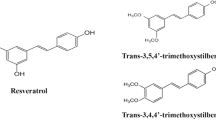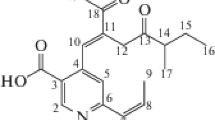Abstract—Septin cytoskeletal proteins are involved in many cellular processes; changes in their expression are a marker of oncological diseases. In this regard, septins can be a potential target for the treatment of cancer cells. To search for new small molecules that affect the structural organization of septin filaments, a virtual screening of the PubChem database compound library was performed and a substance with the highest affinity, the flavonoid procyanidin B3, was selected among all the compounds. Molecular modeling showed that procyanidin B3 interacts with the septin monomer SEPT9 in the region of the G1 and G4 motifs, which are important for GTP binding, and prevents dimerization of septin monomers. Therefore, procyanidin B3 can be considered as a promising compound for affecting the structure of septin filaments in cancer cells.





Similar content being viewed by others
REFERENCES
D. D. Leipe, Y. I. Wolf, E. V. Koonin, and L. Aravind, J. Mol. Biol. 317 (1), 41 (2002).
L. Hartwell, Exp. Cell Res. 69 (2), 265 (1971).
B. Byers and L. Goetsch, J. Cell Biol. 69 (3), 717 (1976).
C. Martinez, M. A. Sanjuan, J. A. Dent, et al., Biochem. J. 382 (3), 783 (2004).
E. T. Spiliotis, J. Cell Sci. 131 (1), 207555 (2018).
F. Calvo, R. Ranftl, S. Hooper, et al., Cell Reports 13 (12), 2699 (2015).
N. Zhang, L. Liu, N. Fan, et al., Oncotarget 7 (38), 61587 (2016).
M. E. Gonzalez, E. A. Peterson, L. M. Privette, et al., Cancer Res. 67 (18), 8554 (2007).
D. Connolly, I. Abdesselam, P. Verdier-Pinard, and C. Montagna. Biol. Chem. 392 (8–9), 725 (2011).
R. K. Singh, K. K. Kim, N. Khazan, et al., BioRxiv 2020, 954529 (2020).
E. A. Marcus, E. Tokhtaeva, S. Turdikulova, et al., Biochem. J. 473 (12), 1703 (2016).
A. A. Rodal, L. Kozubowski, B. L. Goode, et al., Mol. Biol. Cell 16 (1), 372 (2005).
M. Kinoshita, C. M. Field, M. L. Coughlin, et al., Dev. Cell 3 (6), 791 (2002).
M. Sirajuddin, M. Farkasovsky, F. Hauer, et al., Nature 449 (7160), 311 (2007).
M. S. Kim, C. D. Froese, M. P. Estey, and W. S. Trimble, J. Cell Biol. 195 (5), 815 (2011).
K.-I. Nagata and M. Inagaki, Oncogene 24 (1), 65 (2004).
Y. Zeng, Y. Cao, L. Liu, et al., Cell Death & Disease 10, 720 (2019).
C. Pous, L. Klipfel, and A. Baillet, Front. Cell Devel. Biol. 4, 126 (2016).
M. Desouza, P. W. Gunning, and J. R. Stehn, BioArchitecture 2 (3), 75 (2012).
M. Sirajuddin, M. Farkasovsky, E. Zent, and A. Wittinghofer, Proc. Natl. Acad. Sci. U. S. A. 106 (39), 16592 (2009).
E. Zent and A. Wittinghofer, Biol. Chem. 395 (2), 169 (2014).
A. M. Vrabioiu, S. A. Gerber, S. P. Gygi, et al., J. Biol. Chem. 279 (4), 3111 (2004).
M. Farkasovsky, P. Herter, B. Voss, and A. Wittinghofer, Biol. Chem. 386 (7) (2005).
M. Mendoza, A. A. Hyman, and M. Glotzer, Curr. Biol. 12 (21), 1858 (2002).
D. Vardi-Oknin, M. Golan, and N. J. Mabjeesh, PLoS One 8 (8), e73179 (2013).
W. Blum, T. Henzi, L. Pecze, et al., Oncotarget 10 (65), 6944 (2019).
D. Angelis, E. P. Karasmanis, X. Bai, and E. T. Spiliotis, PLoS One 9 (5), e96390 (2014).
K. K. Kim, R. K. Singh, N. Khazan, et al., Sci. Rep. 10 (1) (2020).
L. R. Heasley, G. Garcia, and M. A. Mcmurray, Eukaryotic Cell 13 (11), 1411 (2014).
G. M. Sastry, M. Adzhigirey, T. Day, et al., J. Computer-Aided Mol. Design 27 (3), 221 (2013).
S. Kim, J. Chen, T. Cheng, et al., Nucleic Acids Res. 49 (D1), D1388 (2021).
S. L. Dixon, A. M. Smondyrev, and S. N. Rao, Chem. Biol. Drug Design 67 (5), 370 (2006).
R. A. Friesner, R. B. Murphy, M. P. Repasky, et al., J. Med. Chem. 49 (21), 6177 (2006).
D. A. Case, T. E. Cheatham 3rd, T. Darden, et al., J. Comput. Chem. 26 (16), 1668 (2005).
K. J. Bowers, D. E. Chow, H. Xu, et al., in Proc. 2006 ACM/IEEE Conf. on Supercomputing (SC'06) (2006), p. 84.
D. A. Filimonov, A. A. Lagunin, T. A. Gloriozova, et al., Chem. Heterocyclic Compounds 50 (3), 444 (2014).
O. Trott and A. J. Olson, J. Comput. Chem. 31, 455 (2009).
I. A. Guedes, A. M. S. Barreto, D. Marinho, et al., Sci. Rep. 11, 3198 (2021).
A. Grosdidier, V. Zoete, and O. Michielin, Nucl. Acids Res. 39, W270 (2011).
Y. Liu, M. Grimm, W. Dai, et al., Acta Pharmacol. Sinica 41 (1), 138 (2019).
Y. Lee, Toxicol. Res. 33 (4), 273 (2017).
X. Ye, R. L. Krohn, W. Liu, et al., Mol. Cell Biochem. 196 (1–2), 99 (1999).
U. Lewandowska, K. Szewczyk, K. Owczarek, et al., Nutrit. Cancer 65 (8), 1219 (2013).
K.-C. Choi, S. Park, B. J. Lim, et al., Biochem. J. 433 (1), 235 (2011).
A. Shilpi, S. Parbin, D. Sengupta, et al., Chem. -Biol. Interact. 233, 122 (2015).
G. G. Mackenzie, A. M. Adamo, N. P. Decker, and P. I. Oteizaet, Biochem. Pharmacol. 75 (7), 1461 (2008).
J. F. Burrows, S. Chanduloy, M. A. McIlhatton, et al., J. Pathol. 201 (4), 581 (2003).
V. V. Voevodin, A. S. Antonov, D. A. Nikitenko, et al., Supercomput. Front. Innovations 6 (2), 4 (2019).
ACKNOWLEDGMENTS
This study was carried out using the equipment of the shared research facilities of HPC computing resources at Moscow State University [48].
Funding
This work was financially supported by the Russian Foundation for Basic Research (project no. 19-34-90178).
Author information
Authors and Affiliations
Corresponding author
Ethics declarations
The authors declare that they have no conflicts of interest. This article does not contain any studies involving animals or human participants performed by any of the authors.
Additional information
Translated by D. Novikova
Abbreviations: GEF, guanine nucleotide exchange factor; RMSD, root-mean-square deviation.
Rights and permissions
About this article
Cite this article
Vakhrusheva, A.V., Kudryavtsev, A.V., Sokolova, O.S. et al. Procyanidin B3 as a Potential Inhibitor of Human Septin 9. BIOPHYSICS 66, 887–896 (2021). https://doi.org/10.1134/S000635092106018X
Received:
Revised:
Accepted:
Published:
Issue Date:
DOI: https://doi.org/10.1134/S000635092106018X




